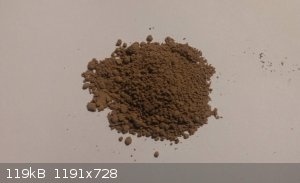night429
Harmless

Posts: 45
Registered: 12-11-2019
Member Is Offline
Mood: 
|
|
Azo dye from p-aminophenol and salicylic acid
I've been wanting to make an azo dye from cheap, OTC chemicals, and I settled on using salicylic acid and p-aminophenol. I found a procedure that I
plan to follow that uses p-aminophenol and 2-naphthol, but I plan on substituting in an equimolar amount of salicylic acid in place of said
2-naphthol.
However, I've only found that both of these compounds can be used in azo dyes, but I've never seen a reference to using both of these together. I
don't know if I didn't research enough, or it's something else, like it doesn't make a very interesting dye, or there's a side reaction that goes on
that makes the formation of the dye difficult.
Thank you in advance!
|
|
|
aromaticfanatic
Hazard to Others
  
Posts: 173
Registered: 10-9-2019
Member Is Offline
|
|
https://www.researchgate.net/publication/282743502_The_azo_d...
This paper mentions salicylic acid azo dyes but no couplings with p-aminophenol.
|
|
|
night429
Harmless

Posts: 45
Registered: 12-11-2019
Member Is Offline
Mood: 
|
|
That paper actually does mention the final product on the middle-right of page 4, called 4,4'-dihydroxy-azobenzene-3-carboxylic acid. It describes how
it was synthesized as a pro-drug of 5-aminosalicylic acid.
"Let's spin apart while racing through the atmosphere"
|
|
|
AvBaeyer
National Hazard
   
Posts: 644
Registered: 25-2-2014
Location: CA
Member Is Offline
Mood: No Mood
|
|
If you check out the forum library you will find several books related to dyes and their syntheses. In particular, see "Fundamental Processes of Dye
Chemistry" page 156. There is a procedure for the coupling of aniline with salicyclic acid. The book is loaded with all sorts of interesting
laboratory procedures.
AvB
|
|
|
night429
Harmless

Posts: 45
Registered: 12-11-2019
Member Is Offline
Mood: 
|
|
Quote: Originally posted by AvBaeyer  | If you check out the forum library you will find several books related to dyes and their syntheses. In particular, see "Fundamental Processes of Dye
Chemistry" page 156. There is a procedure for the coupling of aniline with salicyclic acid. The book is loaded with all sorts of interesting
laboratory procedures.
AvB |
Thanks AvB, I'll check it out!
"Let's spin apart while racing through the atmosphere"
|
|
|
night429
Harmless

Posts: 45
Registered: 12-11-2019
Member Is Offline
Mood: 
|
|
Only replying to say that I was successful in making this compound, and I've attached a picture of it, since I haven't yet found one online. My
procedure was as follows:
I dissolved 0.4g of sodium nitrite into 2.5mL of water. I stirred this around until the nitrite dissolved. In a separate flask, I added around 5mL of
31% HCl into 20mL of water. I then dissolved an estimated 0.6g of p-aminophenol into this solution, stirring until dissolved. (The estimation was
because it was still damp, contaminated with NaHCO3, and the fact that it was slightly decomposed). The color was a brownish-purple.
I then put both flasks into an ice bath, and after around 10 minutes, started to add the sodium nitrite dropwise with manual stirring. After all of it
was added, which took around 5 minutes, the solution was a dull brownish-gray color.
In a separate flask, I dissolved 1.5g of sodium hydroxide into 14mL of water, then added 0.7g of salicylic acid to this. I mixed until everything
dissolved, then put it into the ice bath. After a few minutes, I started to slowly add the diazonated p-aminophenol solution to the salicylic acid
solution with strong, manual stirring, over the course of 5 minutes. The color of the solution, throughout the additions, went from a green, to a
brownish-orange, to an opaque brown.
After it was all added, I stirred it for a few minutes longer, then filtered the precipitate off while it was still cold. Once it was dry, I massed
the precipitate, which came out to be 1.4g of a brown powder.

"Let's spin apart while racing through the atmosphere"
|
|
|
Texium
Administrator
       
Posts: 4516
Registered: 11-1-2014
Location: Salt Lake City
Member Is Offline
Mood: PhD candidate!
|
|
Nice job! Do you have the means to characterize your product?
|
|
|
night429
Harmless

Posts: 45
Registered: 12-11-2019
Member Is Offline
Mood: 
|
|
Thanks! I don't have the means at the moment, since I'm currently at university. I did, however, note a couple observations.
It didn't stain the filter paper at all when drying, meaning there wasn't really p-aminophenol left over (which would've stained the paper a blackish
color upon exposure to moisture and air). It also decomposed thermally with a smoke, which ignites upon touching a flame and burns with a sooty flame;
there was no residue left behind.
Once I get the opportunity, I'm interested in doing a test involving adding some of the dye to a dilute sodium hydroxide solution. Since there's a
carboxylic acid group still on the dye, it should, theoretically, turn into a sodium salt quite easily (assuming it doesn't decompose).
"Let's spin apart while racing through the atmosphere"
|
|
|